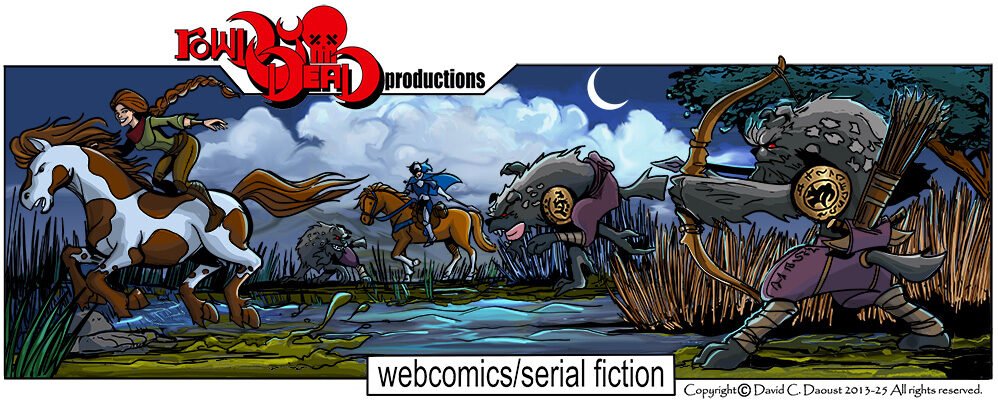
A Whole Lot of Nothing! 8
The Ark Age had come to a close. An age in which mankind had packed themselves away, along with the technology to recreate viable conditions on new planets and moons, for the long trip through the galaxy. A trip to a new sun, a younger sun, a sun that wasn’t threatening to swallow its system whole, to begin an age where mankind was protected and served by a vast fleet of Ark Ships.
It was during this Age that mankind had become so dependent on droids. Each droid was linked to its Ark Ships AI program. In fact all droids were run from its individual Ark Ship, like a body in and of itself with all its moving parts and blood cells. Droids were built to do specific jobs, to lessen the work load of the humans, but most of all, they were built to serve.
This age lasted for thousands of years. So long, in fact, no one remembered what came before.
This was now the Age of the Second Sun, the age in which the Ark Ships finally stopped their long voyage and began to set up shop.
The Ark Ships were the masterminds behind the terraforming of new planets and moons. Droid crews spent decades working to create the living conditions needed for the humans to survive. This is what droids were built to do, this is the task given them long before the Ark Age ever began.
The droids were able to churn out living conditions on these small moons, much faster than planets. Those willing to colonize moons, got a lead on a stable home, able to acquire a life a lot different than those that still lived in City Stations or under domes, waiting for the core planets to be done.
Droids achieved their goal on moons in a fraction of the time it took for full planets.
Moons took to the terraform processes much faster.
A fleet of ships invaded these dead moons. The Temple Ships took position on the North and South Poles, then bore plasma beams deep into the core, heating it to a molten shifting mass, speeding up or slowing down the spin of its orbit, and forcing gasses to broil to the surface. The gasses produced of this process were then sucked into filtering ships. Greenhouse factory ships, that mimicked photosynthesis long enough to create a stable atmosphere, transforming poisonous gasses into breathable air. The droids could then populate the moons with the intricate web of life that made up a stable eco-system. From plants, to insect, to animals, each piece was more important than the last. Every living thing had a part to play.
—
Not all moons were vast deserts, as Twin Crown had turned out to be. Luckily, it was pocked with enough water and vegetation, to maintain a breathable atmosphere, that it was deemed stable enough to move humans onto.
Craiden Haul’s family was amongst the first wave of settlers to hit Twin Crown, all those years ago, long before the port town of Grady was ever an idea. The first wave of colonists crawled the dunes in search of food and water, content with working for their right to survive, to strive for something more than the standard exchange of goods.
Grady was formed later, when more ‘corporate sponsored’ colonist reached the sand moon. Corporations loved moons in which a heavy supply of goods were needed for a colony to thrive. It was considered a good investment. And they did not hesitate to help populate it, nor did they hesitate to sell the goods needed.
The potential for arable soil was deep beneath Twin Crown’s surface. Many of the settlers waited in the hopes that the conditions would change enough for the colony to truly thrive, making them less dependent on resources being brought in. They believed in their moon, and they believed the conditions would shift; these beliefs were not without basis.
Despite Twin Crown’s overall appearance of an honest moon, these heavy dependencies caused Grady’s fall into shadier dealings.
The population expanded to an extent far greater than the moons fledgling economy could support. Where there aren’t enough pieces for everyone, there were going to be those that made sure their piece was the biggest. Having the biggest piece was the easiest way to acquire more; little pieces be damned. Grady wasn’t a safe place to live anymore. And it hadn’t been for a long time.
Craiden did not like what his world had become, though fighting for what the world is, or should be, is like holding back a sand storm. While there were still First Wave Sand Crawlers out in the Dunes, Craiden’s recent dealings lead him to fall in line with Grady’s ways.
Craiden set up a scavenging company. His ‘Crawler’, built for travel through sandy terrain, gave him an edge, and the sheer brawn of his ‘re-purposed’ Mining-bot, Vincent, allowed him to move much larger debris, much faster, than any competitors.
Imagine his delight when his crew came across the abandoned starship in the middle of the desert.

